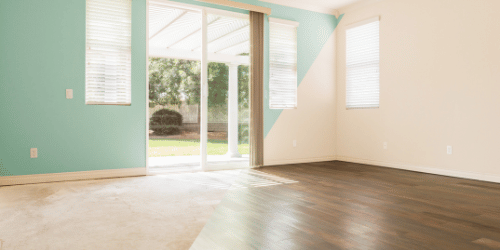Textured walls can add character and depth to a space. But achieving a perfectly smooth finish is essential for a polished look. In this blog post, we’ll explore expert tips, techniques, and best practices for transforming textured walls into sleek, flawless surfaces.
Achieving a smooth finish on textured walls requires attention to detail, proper preparation, and the right tools. Our goal is to guide you through the process and help you achieve professional results.
Understanding Textured Walls
Types of Textured Walls
Common textured wall finishes include orange peel, knockdown, and popcorn, each impacting the room’s appearance in unique ways. Orange peel texture mimics the dimpled surface of an orange, created by spraying joint compound and lightly knocking it down with a trowel. Offering a subtle depth that conceals minor imperfections while providing a modern, refined look. Knockdown texture involves a similar application but flattens the peaks, resulting in a more pronounced, rustic appearance that still hides imperfections effectively. Popcorn texture features a bumpy, irregular surface achieved by spraying a thick compound. Which was once favored for its ability to mask flaws and provide acoustic benefits but now often appears dated and is difficult to clean.
Challenges of Textured Surfaces
Achieving a smooth finish on textured walls can be challenging due to several common issues. Unevenness often occurs when the textured surface has inconsistencies in depth or texture. Making it difficult to apply a uniform layer of joint compound. Visible seams can appear between different sections of compound. Especially if the application is not blended properly, creating noticeable lines or ridges. Imperfections such as dents, bumps, or cracks may be highlighted rather than concealed. Requiring additional layers and careful sanding to correct.
Preparation Steps
To achieve a smooth finish on textured walls. It is crucial to properly assess the existing texture, clean the walls thoroughly, and repair any damaged areas. Start by examining the wall for the type and depth of the existing texture, identifying any uneven spots that may need special attention. Next, clean the walls to remove dust, dirt, grease, or other contaminants that could interfere with the adhesion of the joint compound. This can involve wiping down the walls with a mild detergent solution and ensuring they are completely dry. Finally, repair any damaged areas, such as cracks, holes, or dents, using appropriate filler materials and ensuring a level surface.
Skim Coating Techniques
What Is Skim Coating
Skim coating is a technique used in drywall finishing to create a smooth. Uniform surface by applying a thin layer of joint compound over a wall or ceiling. The purpose of skim coating is to conceal imperfections, such as texture, dents. Or uneven areas, and to prepare the surface for painting or wallpapering. The process involves spreading a thin, even layer of joint compound across the entire surface. Filling in any irregularities and creating a seamless finish. As the compound dries, it can be lightly sanded to further smooth out the surface, resulting in a flawless, polished appearance. Skim coating is especially useful for transforming textured walls or repairing damaged drywall, providing a clean slate for any desired aesthetic.
Materials Needed
For skim coating, essential materials include joint compound, trowels, drywall knives, fine-grit sandpaper (around 220 grit), mixing tools, and primer. Joint compound is the primary material used to create a smooth surface, and it’s crucial to select a high-quality, all-purpose or lightweight type for easy application and sanding. Stainless steel trowels and drywall knives in various sizes (6-inch, 8-inch, and 12-inch) ensure a smooth application and help feather edges effectively. Fine-grit sandpaper is necessary for smoothing the surface after the compound dries, and high-quality sandpaper lasts longer and sands evenly.
Step-by-Step Skim Coating Process
Applying thin layers of joint compound is key to achieving a smooth, level surface. Start with a thin, even coat to fill in any imperfections and allow it to dry completely. Once dry, lightly sand the surface with fine-grit sandpaper to smooth out any inconsistencies and prepare it for the next layer. Repeat this process, applying additional thin coats of joint compound and sanding between each one. Until the desired level of smoothness and evenness is achieved. This technique helps prevent buildup and ensures that the final surface is perfectly level. Providing a professional-quality finish ready for painting or other treatments.
Tips for Quality Craftsmanship
Consistency Matters
Consistent application is crucial when working on textured walls to achieve a flawless finish. It’s essential to avoid applying thick or uneven layers of joint compound, as this can lead to visible imperfections and an inconsistent surface. Each layer should be applied evenly, using steady pressure and smooth, controlled strokes with a trowel or drywall knife. By maintaining a consistent thickness across the entire surface, you ensure a uniform appearance and reduce the need for excessive sanding or additional layers. Careful attention to these details not only enhances the aesthetic quality but also ensures a durable and professional result.
Feathering Edges
Feathering the edges of each coat is essential for a smooth, seamless finish and preventing visible lines or ridges. To achieve this, use a trowel or drywall knife at a shallow angle, applying the compound generously in the middle and gradually decreasing pressure as you move towards the edges. This technique thins the compound at the edges, ensuring a smooth transition between layers. Slightly overlap each stroke with the previous one and blend the edges into the surrounding surface. After each coat dries, lightly sand the edges with fine-grit sandpaper to eliminate imperfections. Repeating this process for each additional layer ensures a professional, polished finish with no visible lines or ridges.
Sanding Techniques
For a seamless finish, use fine-grit sandpaper to gently smooth the surface. Sand in circular motions to evenly blend the edges and remove any imperfections or unevenness. This method helps to achieve a consistent texture and prevents the creation of lines or marks that could be left by linear sanding. Fine-grit sandpaper is ideal because it removes material gradually. Allowing for precise control and reducing the risk of damaging the surface. By sanding in circular motions, you can ensure a smooth and polished finish that blends perfectly with the surrounding areas. Resulting in a professional-looking surface.
Troubleshooting Common Issues
Bubbling and Blistering
Bubbles or blisters can appear during skim coating due to several factors. Such as trapped air, insufficient bonding, or moisture issues. Trapped air occurs when air is caught beneath the layer of joint compound, often resulting from applying too thick a layer or using tools that don’t properly press the compound into the wall surface. Insufficient bonding can happen if the compound doesn’t adhere well to the substrate, possibly due to an unclean or improperly prepared surface. Moisture issues, such as high humidity or wet walls, can also cause bubbles as water vapor tries to escape through the compound.
Cracking and Shrinkage
Cracks can occur after skim coating primarily due to shrinkage, inadequate surface preparation, or structural movement. Shrinkage happens as the joint compound dries and loses moisture, causing it to contract. This is especially common when too thick a layer is applied at once or when the compound contains too much water. Inadequate surface preparation, such as failing to properly clean the wall or not repairing underlying cracks and damages, can also lead to cracking as the compound adheres poorly or unevenly. Structural movement of the building, due to settling or temperature fluctuations, can cause cracks to appear in the skim coat as the walls shift.
Achieving Seamless Transitions
Creating smooth transitions between skim-coated areas and existing textured walls requires careful feathering and blending techniques. To achieve a seamless look, start by tapering the application of the joint compound near the edges where the skim coat meets the textured surface. Use a wide drywall knife or trowel to apply the compound, pressing it firmly against the wall and gradually thinning it out toward the edges. This technique, known as feathering, helps to create a gradual transition without noticeable lines.
Answering Common Questions
Q1 Can I Skim Coat Over Wallpaper?
A1 Address this common query, explain the process and potential challenges.
Q2 How Long Does Skim Coating Take?
A2 Provide a realistic timeline and mention drying times between coats.
Q3 Can I DIY or Hire a Professional?
A3 Discuss pros and cons, encourage readers to assess their skills and time availability.
The Impact of Proper Preparation
Explain how thorough preparation impacts the final result and share before-and-after photos to showcase the transformation.
Seeking Expert Advice
Remind readers to consult professionals for complex projects and provide contact information for Pristine Luxury Remodeling.
Conclusion
In the realm of home remodeling, attention to detail can transform ordinary spaces into extraordinary havens. As we’ve explored the best practices for achieving a smooth finish on textured walls, remember that patience, precision, and passion are your allies. Whether you’re a seasoned DIY enthusiast or working with professionals like Pristine Luxury Remodeling, the pursuit of perfection transcends aesthetics—it’s about crafting an environment that reflects your vision and enhances daily life.
The art of transformation lies in the satisfaction of running your hand across a flawlessly smooth wall, revealing the true potential of your space. Textured walls serve as your canvas, and with knowledge and determination, each layer of joint compound and each stroke of the trowel brings you closer to a masterpiece. The journey from texture to smoothness is not just a physical transformation; it’s an expression of creativity and care. So, whether you’re working on a single accent wall or an entire home, take pride in your craftsmanship, and know that your walls will thank you.
Visit us at Pristine Luxury Remodeling
For more information and personalized guidance visit us at Pristine Luxury Remodeling, We specialize in providing exceptional remodeling services that elevate your space into a masterpiece of luxury.







